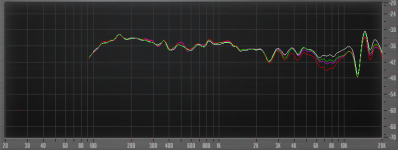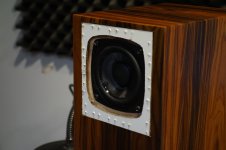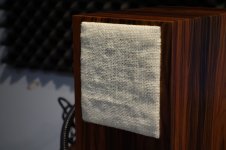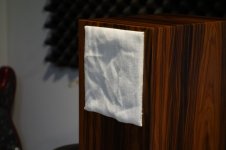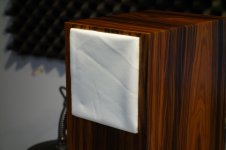Also note it is possible to buy custom made Perforated Metal Speakers Grills -
Custom Steel Speaker Grills Black - Made to Order Black Steel Metal Speaker Grill Baffle Covers to Protect Pro, Car, and Home Audio Speakers.
Though it can get a bit spendy.
Steve/bluewizard
There are loads on ebay or try Maplin.
There is no debate IMO.
OTOH, JBL L100's used acoustic foam for grill covers. -And we know what acoustic foam does...
C
I saw a pair of speakers in a secondhand store that had little quilts for grillecloth.
I don't mean to seem critical, but to debate whether grillecloth affects sound seems to me to be evidence of ignorant people somewhere. Heck, the humidity in the air probably affects the sound. You just can't A/B it.
I saw a pair of speakers in a secondhand store that had little quilts for grillecloth.
I don't mean to seem critical, but to debate whether grillecloth affects sound seems to me to be evidence of ignorant people somewhere. Heck, the humidity in the air probably affects the sound. You just can't A/B it.
Some people cant hear the slight 'shift' of grille's on / off, others can, I can.
I can also hear my systems overall sound change as the barometric pressure rises / falls and the same with humidity.
This cant be poo-poo'd because other things suffer in their own special ways.
Sorry for thread resurrection, but this seemed to be the newest one on grille cloth.
There are some random references around the forum to guilford of maine fr701 -cloth, of which the manufacturer says that "it may be also used as speaker grill cloth" but has anyone here used it? Any comments?
To improve waf I'm searching for grille cloths beyond the basic black/white stretch material and currently the options I've found are either linen (gray-ish) or something from the fr701 color palette. But I don't want to present the options before I know it'll work as a grille cloth.
There are some random references around the forum to guilford of maine fr701 -cloth, of which the manufacturer says that "it may be also used as speaker grill cloth" but has anyone here used it? Any comments?
To improve waf I'm searching for grille cloths beyond the basic black/white stretch material and currently the options I've found are either linen (gray-ish) or something from the fr701 color palette. But I don't want to present the options before I know it'll work as a grille cloth.
Ah, I somehow had not found the specifications part of those guilford cloths, which seem to let at least 95% of the sound through, although the measurements end after 2kHz and the curve is dropping...
So I guess I'll be using "18 count Lambswool Linen Fabric" used in old AR-loudspeakers or something very similar which I can source locally and maybe dye if necessary.
So I guess I'll be using "18 count Lambswool Linen Fabric" used in old AR-loudspeakers or something very similar which I can source locally and maybe dye if necessary.
The Guilford of Maine fr701 Cloth appears to be burlap which is a common cloth for covering Acoustic Absorption Panels, but I'm not sure it would make good Grille Cloth.
The simplest thing to do is go to the Fabric Store and hold various cloths up to the light. The better you can see through them, the more acoustically transparent they are going to be. And it helps if the cloth has a bit of stretch too it so you can pull it tightly over the frame.
Common Double Knit Stretch Fabric does an excellent job and is easy to stretch over the grille frame, and it is reasonably priced. This comes in a variety of colors, and in some cases, a variety of patterns.
Linen type cloth, I think you will find, when you hold it up to the light, you are not going to be able to see through it very well. The weave is too dense.
I think natural fabrics like cotton and wool are going to be too dense, and are going to be too fuzzy, so as to absorb more of the sound. Virtually all modern grille cloths are synthetic material.
It is worth taking a trip to the Fabric Store and just holding a variety of material up to the light to see how well you can see through it. Since we have limited measure of a fabric, the best we can do is get an assessment of a visual transparency.
At the top of this list are, very likely, double knit synthetic fabrics. Common for Stereo Speakers. Toward the end of the list are the heavier grill cloths found on Musical Instrument Speaker, like guitar speakers. Also synthetic.
https://www.parts-express.com/Search.aspx?keyword=grille cloth&sitesearch=true
Again, if you took a trip to the Fabric Store, you would be doing yourself a big favor in understanding the nature of various fabrics.
The simplest thing to do is go to the Fabric Store and hold various cloths up to the light. The better you can see through them, the more acoustically transparent they are going to be. And it helps if the cloth has a bit of stretch too it so you can pull it tightly over the frame.
Common Double Knit Stretch Fabric does an excellent job and is easy to stretch over the grille frame, and it is reasonably priced. This comes in a variety of colors, and in some cases, a variety of patterns.
Linen type cloth, I think you will find, when you hold it up to the light, you are not going to be able to see through it very well. The weave is too dense.
I think natural fabrics like cotton and wool are going to be too dense, and are going to be too fuzzy, so as to absorb more of the sound. Virtually all modern grille cloths are synthetic material.
It is worth taking a trip to the Fabric Store and just holding a variety of material up to the light to see how well you can see through it. Since we have limited measure of a fabric, the best we can do is get an assessment of a visual transparency.
At the top of this list are, very likely, double knit synthetic fabrics. Common for Stereo Speakers. Toward the end of the list are the heavier grill cloths found on Musical Instrument Speaker, like guitar speakers. Also synthetic.
https://www.parts-express.com/Search.aspx?keyword=grille cloth&sitesearch=true
Again, if you took a trip to the Fabric Store, you would be doing yourself a big favor in understanding the nature of various fabrics.
Last edited:
There's a measurement of the linen fabric here:
Replacement Speaker Cloth - Acoustic Research - The Classic Speaker Pages Discussion Forums
which shows about 1dB attennuation in higher frequencies, which I think is quite good performance.
I'll check that double knit stuff if local shops have anything nice enough.
Replacement Speaker Cloth - Acoustic Research - The Classic Speaker Pages Discussion Forums
which shows about 1dB attennuation in higher frequencies, which I think is quite good performance.
I'll check that double knit stuff if local shops have anything nice enough.
There's a measurement of the linen fabric here:
Replacement Speaker Cloth - Acoustic Research - The Classic Speaker Pages Discussion Forums
which shows about 1dB attennuation in higher frequencies, which I think is quite good performance.
I'll check that double knit stuff if local shops have anything nice enough.
those would be my measurements.
The Guilford of Maine fr701 Cloth appears to be burlap which is a common cloth for covering Acoustic Absorption Panels, but I'm not sure it would make good Grille Cloth.
The simplest thing to do is go to the Fabric Store and hold various cloths up to the light. The better you can see through them, the more acoustically transparent they are going to be. And it helps if the cloth has a bit of stretch too it so you can pull it tightly over the frame.
Common Double Knit Stretch Fabric does an excellent job and is easy to stretch over the grille frame, and it is reasonably priced. This comes in a variety of colors, and in some cases, a variety of patterns.
Linen type cloth, I think you will find, when you hold it up to the light, you are not going to be able to see through it very well. The weave is too dense.
I think natural fabrics like cotton and wool are going to be too dense, and are going to be too fuzzy, so as to absorb more of the sound. Virtually all modern grille cloths are synthetic material.
It is worth taking a trip to the Fabric Store and just holding a variety of material up to the light to see how well you can see through it. Since we have limited measure of a fabric, the best we can do is get an assessment of a visual transparency.
At the top of this list are, very likely, double knit synthetic fabrics. Common for Stereo Speakers. Toward the end of the list are the heavier grill cloths found on Musical Instrument Speaker, like guitar speakers. Also synthetic.
https://www.parts-express.com/Search.aspx?keyword=grille cloth&sitesearch=true
Again, if you took a trip to the Fabric Store, you would be doing yourself a big favor in understanding the nature of various fabrics.
I agree, the synthetic double knits are the best fabrics for grille cloths. One of the big killers of HF sound pass thru is fuzz from cloth threads. Burlap is one of the worst offenders. Synthetics like polyester and polypropylene have smooth outer surfaces.
I never heard a difference with the front fabric or without !
I believe if someone can hear Something : this is the frame but not the fabric on it ! also some are not damped (need rubber plugs to attach it on the front bafle) !
You need thick tee-shirt on a tweeter or a mid to hear attenuation ! But in A/B, never see a guy able to make a difference ! And this is the easiest blind test to do !
Anywhay, they should be like the one they made for the Boston Acoustic Lynnfield serie for instance !: no resonant plastic open frame (side frames are also empty )!
WHen Something hears a difference I bet for an off axis of his head : many speakers are directiv enough to sound different with just 1 or 2 cm of lateral or in depth head moving !
http://www.canuckaudiomart.com/details/135589-boston_acoustics_lynnfield_400l/images/155898/
anyway we talk about the tweeter only if Something is hearable ! Maybe AMT and Ribbon, ESL are more sensitive to front wooden frame ! But not so sure : what is the names of the big metal polarized frames on a ESL ? Do you think you can hear less than a wirered stator for instance ??? I'm not sure !
I believe if someone can hear Something : this is the frame but not the fabric on it ! also some are not damped (need rubber plugs to attach it on the front bafle) !
You need thick tee-shirt on a tweeter or a mid to hear attenuation ! But in A/B, never see a guy able to make a difference ! And this is the easiest blind test to do !
Anywhay, they should be like the one they made for the Boston Acoustic Lynnfield serie for instance !: no resonant plastic open frame (side frames are also empty )!
WHen Something hears a difference I bet for an off axis of his head : many speakers are directiv enough to sound different with just 1 or 2 cm of lateral or in depth head moving !
http://www.canuckaudiomart.com/details/135589-boston_acoustics_lynnfield_400l/images/155898/
anyway we talk about the tweeter only if Something is hearable ! Maybe AMT and Ribbon, ESL are more sensitive to front wooden frame ! But not so sure : what is the names of the big metal polarized frames on a ESL ? Do you think you can hear less than a wirered stator for instance ??? I'm not sure !
Last edited:
Measurements
I measured a full-range driver at 6" mic distance, 10 degrees off-axis with 3 different fabrics wrapped around the grille frame, though not stretched. The speaker was taped to the table so it would not move between measurements. I'm also attaching photos showing the fabrics.
I measured a full-range driver at 6" mic distance, 10 degrees off-axis with 3 different fabrics wrapped around the grille frame, though not stretched. The speaker was taped to the table so it would not move between measurements. I'm also attaching photos showing the fabrics.
- white: grille frame with no fabric
- green: craft burlap material
- magenta: linen
- red: double-knit
Attachments
The guys at Linn and B W are likely speaking about reasonably transparent grill cloths used over high mass drivers( high mass compared to film types), AND they likely dont mean issues with grill frames
Within the reasonably transparent stuff there is usually only small differences AND those differences are usually above 10 khz where a small reduction is not easily noticed by most.
Start throwing extreem materials like overly thick burlap over a tweeter and you of course will get attenuation enough to change the voicing. For instance -1-2 db between 5-10 khz is not hard to notice on a system thats well designed.
recently I did both measure and listen test comparing a buch of different grill materials for a ribbon. We found that -2 db at 20 khz simply wasnt noticed both by young and old ears and most of the thinner and more open cloths / wires mess/ window screen, etc were capable of keeping loss to below 2 db at 20k.
We did not goto extremes to see what thickness / weave etc resulted in lossses that we could actually hear. We found a few things that worked and had no noticeable effect at listen, recorded the data and moved on realizing that this issue may be hype more than necessary
Within the reasonably transparent stuff there is usually only small differences AND those differences are usually above 10 khz where a small reduction is not easily noticed by most.
Start throwing extreem materials like overly thick burlap over a tweeter and you of course will get attenuation enough to change the voicing. For instance -1-2 db between 5-10 khz is not hard to notice on a system thats well designed.
recently I did both measure and listen test comparing a buch of different grill materials for a ribbon. We found that -2 db at 20 khz simply wasnt noticed both by young and old ears and most of the thinner and more open cloths / wires mess/ window screen, etc were capable of keeping loss to below 2 db at 20k.
We did not goto extremes to see what thickness / weave etc resulted in lossses that we could actually hear. We found a few things that worked and had no noticeable effect at listen, recorded the data and moved on realizing that this issue may be hype more than necessary
Last edited:
I would agree that most people will not be troubled by -1 or -2 dB at 20 kHz, whereas the 5-10 kHz range is very important. My goal here was to provide measurements rather than focus on subjective listening reports.
I found it counter-intuitive that the burlap material I tested had much LESS effect than the double-knit material I grabbed off the shelf in the fabric store, and that the latter caused a -4 dB dip in a very critical frequency band. This craft burlap is probably more flimsy than what you'd use on a farm, and is pretty easy to see through.
The bottom line is that you do have to be careful to select thin material OR well-perforated material.
BTW I don't think the driver mass has any influence over its sensitivity to grille cloth. A ribbon tweeter or a full-range dynamic driver will be attenuated by the same degree by a given material at a given frequency. Driver mass has no bearing once the acoustic sound wave has been created. Though driver surface area may have a bearing: the wave from a nearly point-source driver like a dome tweeter travels through a much smaller portion of the grille than that from a long ribbon tweeter or a planar magnetic driver.
I found it counter-intuitive that the burlap material I tested had much LESS effect than the double-knit material I grabbed off the shelf in the fabric store, and that the latter caused a -4 dB dip in a very critical frequency band. This craft burlap is probably more flimsy than what you'd use on a farm, and is pretty easy to see through.
The bottom line is that you do have to be careful to select thin material OR well-perforated material.
BTW I don't think the driver mass has any influence over its sensitivity to grille cloth. A ribbon tweeter or a full-range dynamic driver will be attenuated by the same degree by a given material at a given frequency. Driver mass has no bearing once the acoustic sound wave has been created. Though driver surface area may have a bearing: the wave from a nearly point-source driver like a dome tweeter travels through a much smaller portion of the grille than that from a long ribbon tweeter or a planar magnetic driver.
the sensitivity to grill cloth in low mass ribbons and other planers in my experience has more to do with altering the subjective dynamics.
a few years back I was developing a large surface area but very low mass full range curved planer magnetic. Mass similar to an electrostat. Very thin materials.
Grill cloths that were heavier and less "open" in weave seemed to soften some of the lively micro dynamic stuff. As if the lower volume performance wasnt as good.
All very subjective but consistently noticeable. Eventually I found info that fit with this phenomenon. As far as I can tell if the grill cloth is close to the driver and of a tight weave, then the cloth can move in sympathy with the diaphragm and in effect add to its mass and alter mid range to bass balance.
a few years back I was developing a large surface area but very low mass full range curved planer magnetic. Mass similar to an electrostat. Very thin materials.
Grill cloths that were heavier and less "open" in weave seemed to soften some of the lively micro dynamic stuff. As if the lower volume performance wasnt as good.
All very subjective but consistently noticeable. Eventually I found info that fit with this phenomenon. As far as I can tell if the grill cloth is close to the driver and of a tight weave, then the cloth can move in sympathy with the diaphragm and in effect add to its mass and alter mid range to bass balance.
Last edited:
Grill cloth would have an effect but I don’t think it will show up very well in a frequency response measurement. This would show up better in a time domain measurement such as impulse response or spectral waterfall plot. This is where I think the “softening” becomes audible...where there is subtle blurring of transients due to stored energy between the grill cloth and driver diaphragm. This stored energy would be masked in a frequency response measurement...no pun intended.
- Status
- This old topic is closed. If you want to reopen this topic, contact a moderator using the "Report Post" button.
- Home
- Loudspeakers
- Multi-Way
- Speaker Grill clothes affect on sound quality debate?
